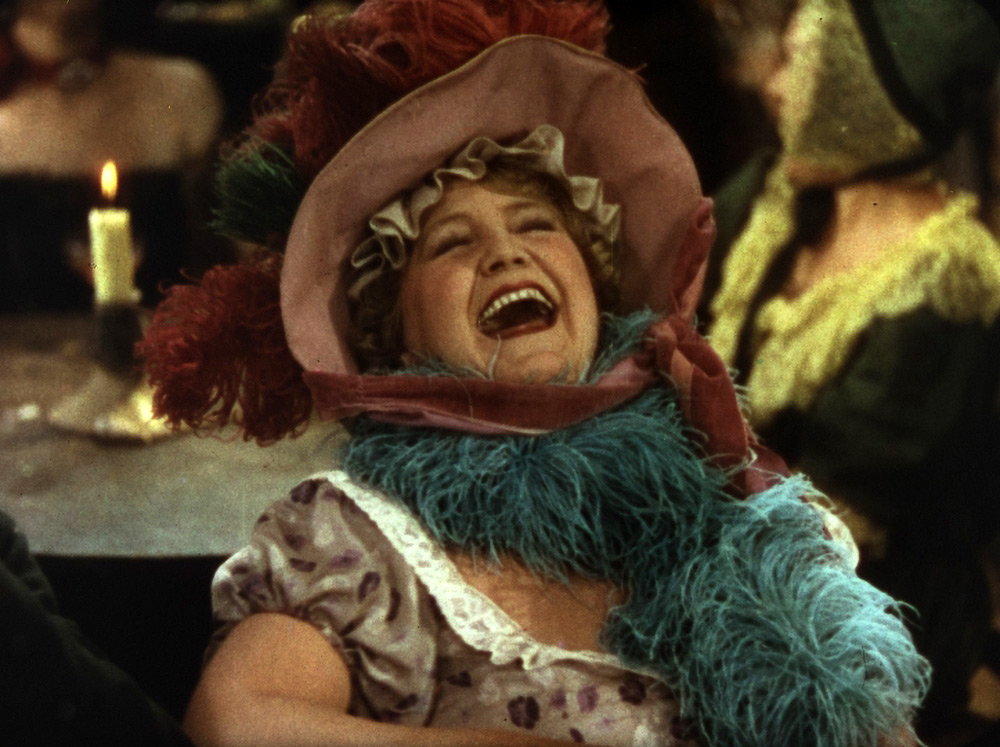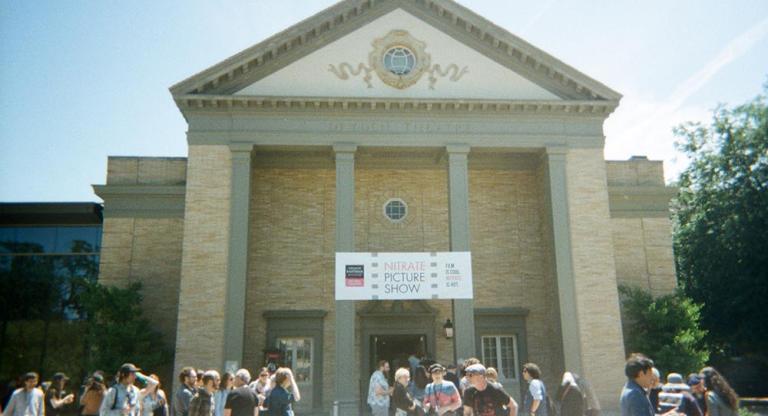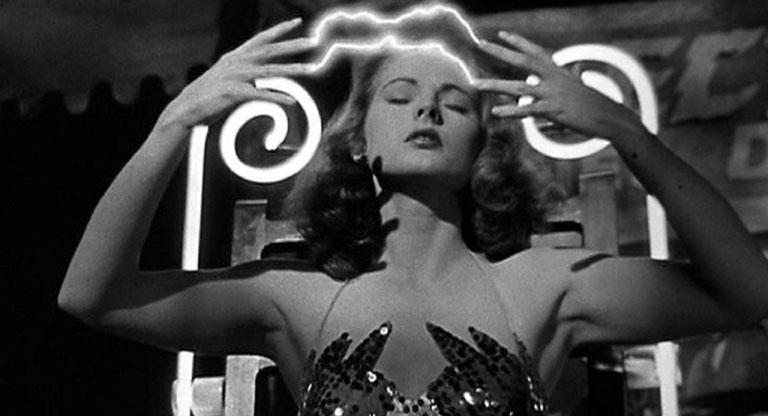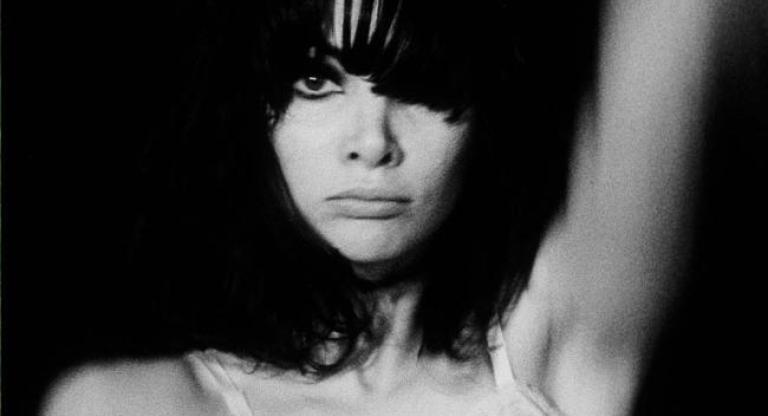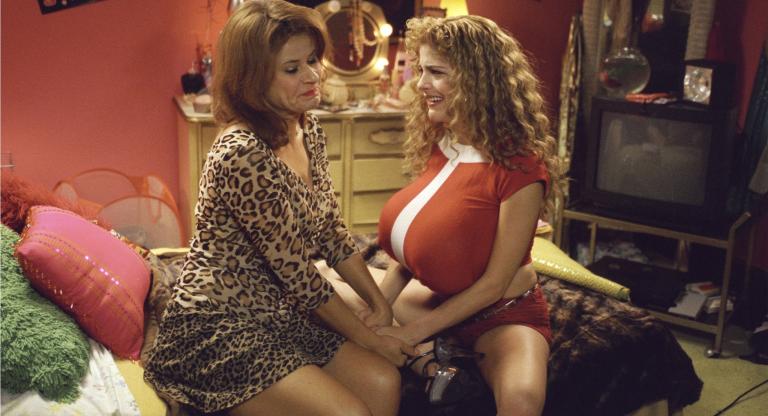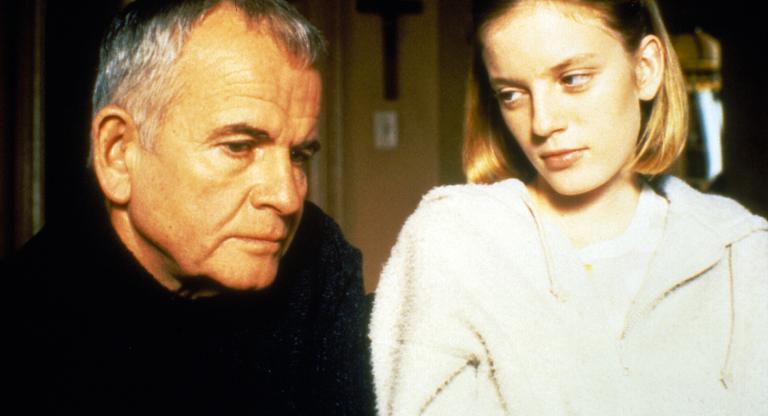I never could understand the motivations of “Summer Camp People”––those seasonal blooms flowering between Memorial Day and Labor Day in the Adirondacks, Berkshires, and the Poconos––who live only for a few months as some truer self. The idea of a discrete, fleeting window in which one can unleash their most gregarious and lively persona was (and remains) completely alien to me, as I conduct myself in a gregarious and lively manner year round. But as pals from home and abroad poured forth from little “bunks” of Air BnBs and econo-suites scattered across Flower City, the unique feeling of seeing camp pals once a year brought a froth of nostalgia to this year’s Nitrate Picture Show. Armed with my newfangled reading glasses and a weekend’s worth of “movie medicine,” I dove headfirst into another year at the George Eastman Museum’s marathon celebration of conservation and exhibition.
The promise of American summer camp, as best I can tell, is a bucolic home away from home––an exercise in rustication and cooperation meant to imbue growing boys and girls with an appreciation for the outdoors and a sense of comradeship. Here is where the similarities cease, as the Nitrate Picture Show is a decidedly indoor kid pastime, an endurance test sought and conquered by the most devoted and curious cinephiles. After nearly a decade, the capable staff at the Eastman have built and maintained a well-oiled machine. But even the most efficient mechanisms catch a wrench in the gears now and again. This year was no exception.
For the first time, Patron-level passholders were entitled to an assigned seat, guaranteeing the same place at every screening. (Time will tell whether this remains the norm; I heard one anecdotal account of someone stuck in an assigned seat behind a tall patron, making the soft subtitles beneath the screen nearly impossible to read.) A caste system has reared its ugly head in our niche little nest, carving a stark dividing line between the upper crust and us unwashed masses: Festival, Press Pass, and walk-up ticket holders queuing up in the parking lot before the show. A gift bag mix-up, where select members of the hoi polloi received a Blu-Ray of Pandora’s Box meant for Patrons, earned a mention in more than a few pre-film intros, alongside an earnest entreaty to return these spoils to their rightful owners. (I’ve yet to hear whether anyone in general admission steerage surrendered this precious cargo.)
As with festivals past, certain motifs and throughlines came into focus while the weekend wore on. Whether these were deliberate thematic choices on the part of the festival curators, my own critical bias, a common thread found in films of the 1930s and ‘40s, or some happenstantial combination, remains a mystery. Despite having seen only a few films in the festival, I was determined to take an old-fashioned materialist approach to this year’s scene report: call it “How the Other Half Lives at Nitrate.” (Honorable mention goes to longtime pal Nina Riddel’s alternate title, “The Freaks Come Out at Nitrate”)
Among our merry band, friends noted the prevalence of gambling debt as plot device in films like opening night bonbon Becky Sharp (Rouben Mamoulian, 1935, pictured at top), Friday morning’s Technicolor western Canyon Passage (Jacques Tourneur, 1946), and Saturday evening’s Argentinian noir Hardly a Delinquent (Hugo Fregonese, 1949). Whirring roulette wheels and shuffling decks make an irresistible siren song for the ambitious officer’s wife, the puff-chested prospector, and the neurotic office clerk, tempting the doomed listener with short cuts to a worry-free life and respect from one’s betters.
The wrong side of the tracks in Pittsburgh, PA, and New York City were well on display in WPA propaganda piece The City (Ralph Steiner and Willard Van Dyke, 1939), a snappy 44-minute advertorial produced for the 1939-40 World’s Fair Exhibition in Flushing, Queens. Opening shots of idealized Massachusetts village life give way to an apocalyptic vision of a Pittsburgh steel mill. Smoke stacks “poison our air, poison our water” intones the ominous narration, while vérité footage of New York’s towering skyscrapers rise above the streets like filing cabinets, packed to the brim with toiling office drones. Even our food is divorced from Mother Nature’s womb: kinetic, Vertov-esque montages of automatic pancake makers, bread slicers, and samovars work tirelessly to nourish the urban lumpenprole. Surely, there must be a better way! And in 1939, that light at the end of the tunnel was Green Belt, Maryland: Roosevelt’s planned suburb avant la lettre, complete with a passable town center and ample highways.
Released two years before the 1939 World’s Fair, proto-noir You Only Live Once (Fritz Lang, 1937) injected the sensational Bonnie and Clyde lovers-on-the-run story with a still-timely plea for criminal justice reform. Coltish Henry Fonda plays Ed Taylor, a newly-freed getaway driver with a checkered past—stints in reform school, prior convictions—whose attempts to walk the straight-and-narrow are thwarted at every junction by the invisible hand of capital. Never mind that Taylor’s ambitions are considerably more modest than those of the protagonists in Becky Sharpe, Hardly a Delinquent, et al. For want of a house, Taylor’s fate is sealed, with a case of mistaken identity sending him and pregnant wife Sylvia Sidney back on the lam. Heaven help the poor schmuck who reaches above his station, catching in his calloused hand a hangman’s noose in lieu of a brass ring.
The bell curve of sexual mores tolls high above the never-ending carousel of La Ronde (Max Ophüls, 1950), a Belle Epoque Vienna-set antecedent to what curator and archivist Elizabeth Purchell rightfully clocked as the “A meets B, B meets C, C meets D” porn premise. Streetwalkers and soldiers conduct their business in a darkened alleyway; a rakish nobleman and a liberated stage comedienne commingle backstage and at country inns. Only the middle class burghers and businessmen muster a blush: the student and his chambermaid convene while his folks are in the country; a young man and a married woman meet in a tucked-away sublet; her cuckold husband and a demure coquette satiate their appetites in one of Vienna’s baroque private dining rooms. Whether peasant or prince, worker or parasite, only eros can surpass the motivating power of mammon.
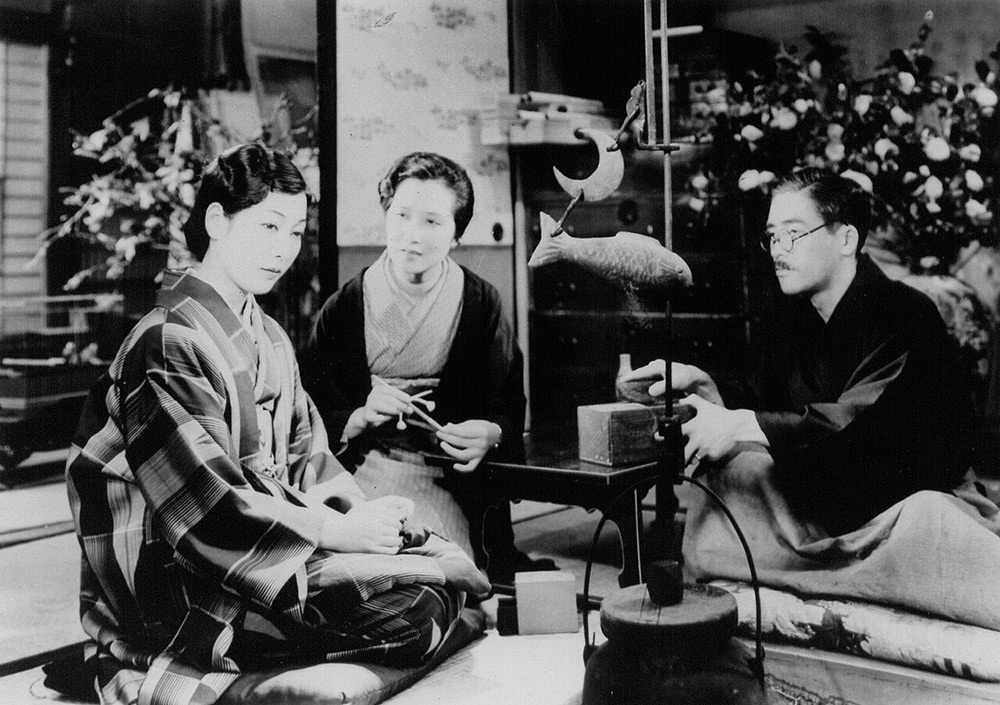
Where opening night film Becky Sharp depicted the venal and conniving side of ambitious womanhood, a more tender perspective awaited in Wife, Be Like a Rose! (Mikio Naruse, 1935), among the Japanese auteur’s most celebrated pre-war efforts. Released stateside as Kimiko to a curious, and often condescending American critical response, Naruse’s titular heroine embodied the auteur’s oft-explored themes of sexual liberation and societal expectation, standing in for the Empire’s ongoing tug-of-war between tradition and Western-style modernity. Star Sachiko Chiba typifies Japan’s emerging “moga” archetype as the career-driven only child of a celebrated lady poet and her long-absent husband, who some 15 years prior deserted his Tokyo family for a rustic mountain shack and his geisha companion. Bittersweet to the very last, Rose tenderly and earnestly enumerated the myriad indignities of the traditional family: the “Other Woman” who tore Kimiko’s home asunder repents with the coin of the realm, sending her husband’s abandoned wife and daughter monthly sums at the expense of her own children.
Rounding out the screwball comedy section of the Nitrate food pyramid, Sunday matinee My Man Godfrey (Gregory La Cava, 1936) spread itself before me like an appetizer sampler of the festival’s class-conscious theme. Godfrey’s myriad virtues are well documented by better scribes than I, but the vaguely-socialist third act felt like a deliberate rejoinder to the striving and scrabbling on-screen all weekend. Nevermind that William Powell’s bum-turned-butler boasts a Harvard diploma and a Back Bay pedigree; his meteoric rise from “forgotten man” to affordable housing advocate and nightclub impresario is truly the stuff of Hollywood fantasy. Just as Steiner and Van Dyke’s The City cannot imagine improving upon the slums in its downcast stare, La Cava’s Depression-era Cinderella story makes a full-throated plea for means-tested relief. It is good, honest work—not housing, healthcare, or food—that will set us free.
If you’ll pardon my casual reference to the gates of Auschwitz, then you’d make “a perfect audience,” per senior Eastman Museum curator Peter Bagarov, for this year’s Blind Date with Nitrate—perhaps the biggest gamble in a weekend littered with stories of IOUs and desperate cash grabs. The final Sunday screening is often among the festival’s most anticipated: past surprises included Michael Powell and Emeric Pressberger’s Gone to Earth (1950) and Carl Theodor Dreyer’s Day of Wrath (1943), to name two celebrated selections. This year’s Blind Date boasted more than a few “distinctions,” least among them an extended introduction from festival founder Paolo Cherchi Usai, who set the stage with an anecdote from his salad days as a burgeoning cinephile.
To hear Usai tell it, his nascent love of the moving image was cultivated by two “separate but equal” mentors: a Jewish-Italian film scholar and a Palestinian film collector with a penchant for, of all people, D. W. Griffith. Eager to guess the mystery film, I seized upon this mention of filmdom’s problematic great-grandfather, expecting a bookend to last year’s opening night presentation of Intolerance (1916). Taking the podium, Bagarov’s scanty follow-up remarks gave us little to go on: “If you don’t know the film, but you know the director, watch with an open mind.” All this equivocating and hemming and hawing—where could it possibly lead?
After what felt like an especially long curtain rise, a ripple of whispers disturbed the calm surface of the Dryden audience. Our final screening, after these nitrate scenes from the class struggle, was The Journey to Tilsit (Veit Harlan, 1939), an update of F. W. Murnau’s Sunrise (1927) from the ur-edgelords that brought you notorious Third Reich propaganda mainstay Jud Süß (1940). Though I definitely did “Nazi” that one coming, I followed orders and went in blind. If nothing else, Harlan’s heimat outing proved one of my pet film theories: without the contribution of Germany’s Jewish writers, designers, actors, and technicians, their film industry really fell off.

Last year’s now-notorious Letterboxd review of Meet Me in St. Louis (1944)—reprinted this year on custom t-shirts by two festival goers, I might add—was, within hours of the Blind Date, quickly supplanted by a post on the r/Rochester subreddit questioning the logic of the film’s selection. Over post-screening dumplings and mapo tofu at Szechuan Opera—and, later, with a hard seltzer in hand at sprawling gay bar Bachelor Forum—my fellow campers and I speculated on the rationale behind slotting a Third Reich joint into the coveted Blind Date spot. To what could we attribute this controversial choice? Perhaps a lack of confidence in the Nitrate audience? How could that be? This was the same willing crowd that passionately laughed and cried through heart-wrenching 1936 melodrama The Final Chord, made in Nazi Germany shortly before director Douglas Sirk’s own escape to Hollywood.
With a mix of seasoned cinephiles, scholars, and archivists, I can think of no festival audience better suited to endure Harlan’s schmaltzy love triangle between a blonde hausfrau, her strapping sheygets husband, and the raven-haired “Polish hussy” who steals him from the marital bed. I myself come from a long line of Polish hussies, and thus derived a perverse pleasure in watching this “rootless cosmopolitan” femme fatale run roughshod over the sacred altar of the German nuclear family. (In my defense: my schadenfreude was tempered when I learned that The Journey to Tilsit was released in November 1939, just two months after the Siege of Warsaw.)
The surprise exhibition of a Nazi film, by a noted Nazi propagandist, did little to ruffle me from a secure vantage in the fourth row. Nor did the previous day’s screening of Disney’s 1933 Merry Melody Three Little Pigs, presented in its original iteration with the Big Bad Wolf’s disguise as a stock Jewish peddler. Moviegoing, while ranking high among life’s greatest pleasures (alongside gambling and husband-stealing), isn’t always Technicolor splendor. Rather, this element of shock and surprise augments the Eastman Museum’s “festival of conservation,” from the opening day line-up announcement to the great reveal on Sunday night. Whether safely ensconced in your reserved seat, or muscling through crowds for a good sightline, at Nitrate as in the game of life, sometimes the best you can do is roll the dice.
